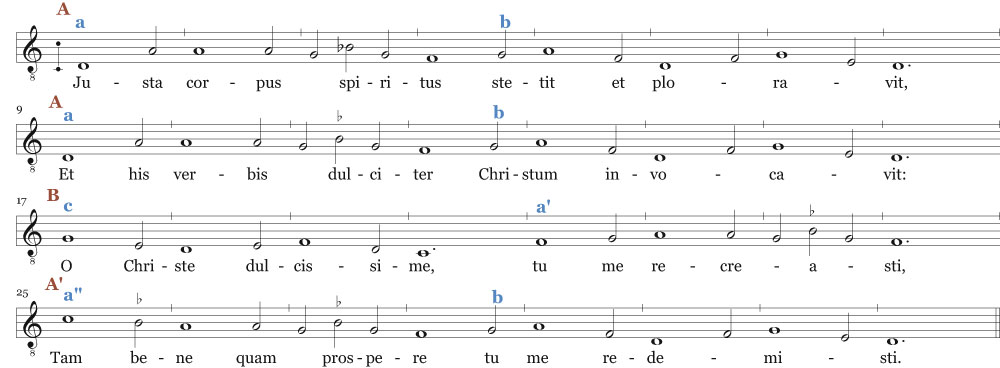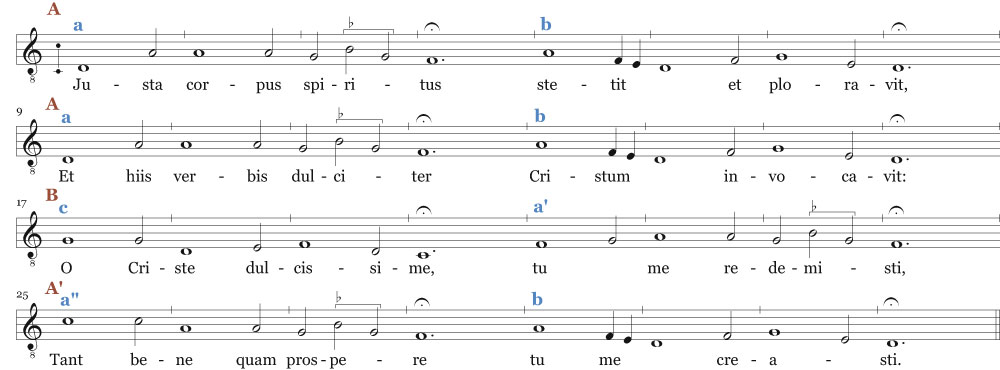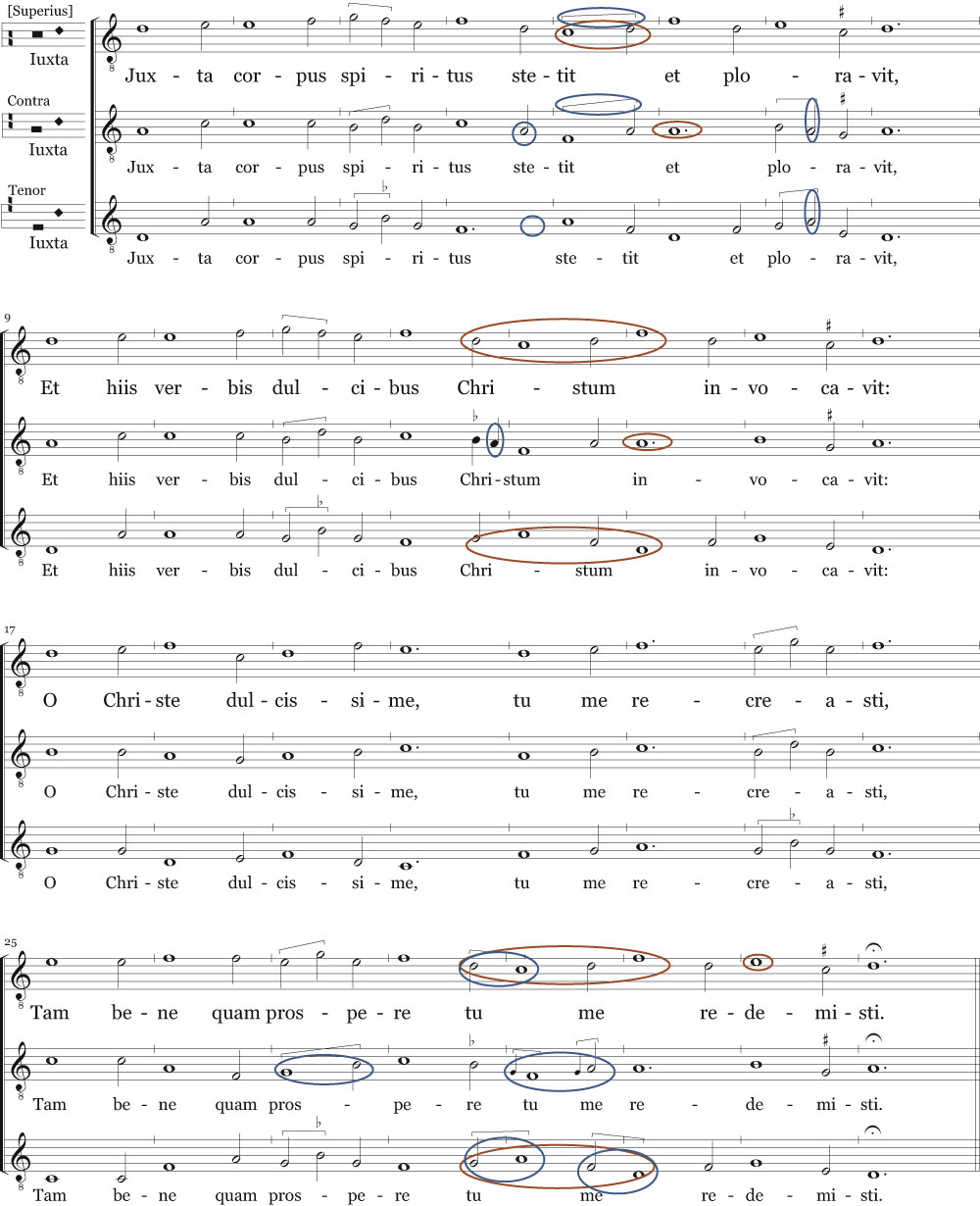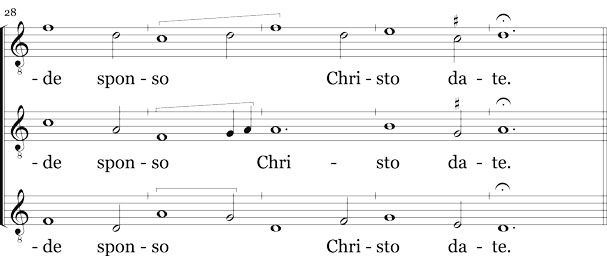Notes on the reworked stanzas of »Juxta corpus spiritus stetit«
The three-part setting of »Juxta corpus spiritus stetit«, ff. 18v-28, in MS Amiens 162 consists of ten stanzas using in principle the same music. The stanzas exhibit, however, a great variability in musical details. The tune in the tenor can be found in a contemporary two-part setting, which has been preserved in two different versions in the MSS Tübingen, Universitätsbibliothek, MS Mk 96, ff. 13v-16v + 10, and Grand-Saint-Bernard, Bibl. de l’Hospice, Ms. 6, pp. 208-23 respectively (all the settings are published in the Amiens 162 Edition as no. 5 including Appendices). The tjree-part setting is simple: It is in triple time, the superius is a counter voice to the tenor tune in contrary and parallel motion, and the “Contra” completes the sound in the same range as the “Tenor”, often following the superius in parallel fourths.
This simple setting has been varied in two or more stages in order to fit the music to the varying number of syllables and the changing word formations of the text. But apparently it has been just as important to create some variation in sound during a lengthy performance of its many stanzas. This is highly interesting. The desire for variation has moreover disguised the outline of the tenor tune, which only appears in its original shape in stanzas 4-9 because of an interchange of notes in tenor and contra in bars 25-26 in stanzas 1-3 and 10. Some of the variations in the music were made before it was copied, but many more result from using the music in performance and then changing unsatisfactory details by erasure and rewriting. We can follow the process on the pages of Amiens 162. The result of these many changes is that the notation of the stanzas probably has become difficult to understand for users outside the circle, where the changes were made. An intimate knowledge of the basic rhythmical and harmonic pattern of the setting was needed to make the notation adequate for its intended use.
We find this original pattern in stanza 7 “Confessor N”, where worshippers as occasion required could insert a local saint with – preferably – a name of four syllables. This stanza was never used, and therefore it has not been reworked – neither before the copying into Amiens 162 nor later. It is regularly structured and represents the original foundation for the composition (See ex. 1). The lines of the poem here have their maximal length; the first two line of the stanza with the rimes aa each consists of 7+8 syllables, and the last two lines riming bb of 7+7 syllables. The lines are set almost syllabic in uniform segments: A (a-b), A (a-b), B (c-a’), A’ (a”-b).
Example 1, “Juxta corpus spiritus stetit”, stanza 7, ff. 24v-25.

If we compare the tenor tune of stanza 7 with the versions of the tune used in the two-part setting, which are reproduced in examples 2a-b, we find that the Amiens 162 version is nearly identical to the one in Tübingen 96. The only differences are that Tübingen 96 does not use ligatures and that differences concerning two unaccented pitches appear (e instead of g in bar 17.3, and b instead of c’ in bar 25.3). Grand-Saint-Bernard 6 agrees with Amiens 162 on these two pitches, but uses the ligatures in a slightly different way, which strongly influences the perceived rhythm of the song. The decisive difference in Grand-Saint-Bernard 6 is the elimination of the upbeat note g, which connects the segments of the A- and A’-lines (bars 4.3, 12.3 and 28.3). This elimination creates a very homogenous flow with a prime or fifth sonority sounding for a perfect brevis bar every fourth bar. Exactly this note bridging the segments of the A-lines, which the two-part setting in Tübingen 96 handled in the most natural way, turned out to cause great difficulties and probably some speculation during the process of revision, which we can follow on the pages of Amiens 162.
Example 2a-b, tenor voice of “Justa corpus spiritus stetit” 2v, stanza 1, in
a) Tübingen, Universitätsbibliothek, MS Mk 96, ff. 13v-14, and

b) Grand-Saint-Bernard, Bibl. de l’Hospice, Ms. 6, pp. 208-09.

It is important to keep some points in mind if we want to understand the ten stanzas as they appear in Amiens 162. Firstly, that the initials and the text were written in as the first on the openings, only thereafter came the staff lines and the music. Secondly, that the exemplar probably was exactly notated as regards rhythm with the use of two note values: long (black square notes) and short (black rhomboid notes or c.o.p.-ligatures). Thirdly, that the reworking of the music happened in two stages, namely as a result of Hand A’s efforts during the copying process (he may simply have copied his exemplar exactly or only made small adjustments), while the greatest part of the reworking can be ascribed to a later user, who with great probability was Antoine de Caulaincourt.
Hand A’s adjustment of the music to the changing number of syllables was made during the writing of the music. Many perfect breves have been made unmistakable by a punctus (divisionis/additionis), and notes have been written together in ligatures above a single syllable or placed in such a way that their distribution in relation to the text was reasonably obvious. The result of this work was a row of relatively homogenous stanzas with a bit of variation in sound and a passable adjustment of the notes in relation to the text, but still exhibiting some ambiguous points, which could hamper a performance.
Caulaincourt has tried to remedy these deficits. He apparently wanted to create a more variegated development in the many repeated stanzas, and also to get rid of the elements that he found disturbing. Both persons involved in the precess had a restricted knowledge of mensural notation. Some of the ligatures used can be interpreted mensurally (for example short-long), but nonetheless in many places the upward tails of c.o.p.-ligatures (halving the note values) have been omitted, which makes their rhythmical meaning unclear. Caulaincourt simply ignored the rhythmical element. He combined square and rhomboid notes with a stroke or added freely extra notes to existing formations and thus produced ligatures in unorthodox ways. And after erasing single rhomboid notes, he often replaced them with square notes (cf. the comments in the transcriptions). We have to conclude that the notation did not convey any rhythmical information for Caulaincourt, and that he, as was normal in chant notation, regarded ligatures as indications only of how to distribute the words.
This means that the rhythmical and harmonic pattern clearly put forward in stanza 7 probably has to be retained also in the reworked stanzas. Where the later user has added an extra note in ligature to a semibrevis, common sense tells us to perform the ligature as two minimae. But in other cases, when a perfect bar containing a brevis and a semibrevis has been replaced by one or two ligatures consisting of four notes in all, it becomes absolutely uncertain how to sing the passage. In the last cases, the notes belonging to the basic pattern are in the transcriptions notated as normal notes, while the added notes have been placed as grace notes before and after (cf. ex. 3, bar 29 in the contra).
Example 3, “Juxta corpus spiritus stetit”, stanza 1, ff. 18v-19.

If we now compare the beginning of the song (Example 3) with the ‘unused’ stanza 7 (ex. 1), we can at once note that the intervention that interchanged the notes of the tenor tune and the contra in bars 25-26 in stanza 1 – just like in stanzas 2-3 and 10 – was done prior to the copying, that it belongs to the history of the setting before it found its way into the workshop of Hand A. In the same way, the following changes stem either from the exemplar or from Hand A while he distributed the notes above the text, which here has only six syllables in the second part of the lines (cf. the red markings in the music example):
Bar 5, brevis and semibrevis have been written closely together above “-tit” in superius and contra.
Bars 6.3 and 14.3, the scribe has omitted the semibrevis a in the contra and instead added a punctus to the brevis.
Like in bar 5 the notes have been placed closely together in superius and tenor in bars 12-14 and 28-30 above the words “Christum” and “tu me”.
Bar 31.1-2, in superius he has not written a ligature but a brevis e’ only.
By these means he has copied a version of the first stanza, which is hardly distinguishable from stanza 7 except for the voice interchange in bars 25-26, but with the shorter lines of text clearly co-ordinated with the music. This has been the starting point for the real reworking of musical details by the later user (the blue markings):
Bar 5, the notes in superius and contra have been connected with strokes into ligatures in order further to clarify the text underlay.
Bar 4.3, the note b in contra has been erased and replaced by a brevis a, and in tenor the note g has been erased.
Bar 7.2, both in tenor and contra an a has been added to the brevis filling the two first beats in the bar.
Bar 12.3, in the contra, a rhomboid a has been inserted after the semibrevis b.
Bar 27.1-3, in the contra, the note g has been erased end then rewritten in ligature with b.
Bar 28.3, the note d’ has been erased in the superius and then rewritten in ligature with the next note, c’.
In the same way, the tenor’s g and a have been erased and rewritten as a ligature in bars 28.3-29.2, and the note d bar 30.1 has been erased and added to f in ligature.
In bar 29 in the contra, two g’s have been added to the already existing notes, brevis f and semibrevis a.
By this revision Caulaincourt succeeded in making the three bridging passages between the first and the second segments in the A- and A’-lines different, where they all were similar in stanza 7. This is an effort that far exceeds the purpose of fitting of the music to the variable text lines. As already mentioned, exactly this g, which connects the A-lines and is omitted in the Grand-Saint-Bernard 6 version, seems to have displeased him, and even more so in its three-voice harmonization with a triad based on g – the note b in the contra has according to common practice (musica ficta / falsa) to be inflected to remedy the tritone leap b-f. He has made a great many efforts to avoid the tritone; probably his knowledge of the use of inflections in polyphonic music was as scarce as his experience with mensural notation. On the other hand, he did not change much in the B-line of the song. It simply does not show up similar problems, and he only added a few decorative notes in two of the last stanzas.
If we disregard the different solutions he created concerning the co-ordination of music and text by the use of ligatures and repositioning of notes, we can follow his attempts to solve his problems through the stanzas (a tabulation of all the changes he made on the pages of Amiens 162, and which I have been able to discern, can be found in the table ‘Changes in the music of »Juxta ...’):
In stanza 2, bar 4.3, he erased the note b in the contra and replaced it by a ligature a-f, but let the tenor keep its g – strongly dissonant! In bar 12.3 the tenor’s g is erased and replaced by d; the contra is not changed. In bar 28.3, the contra’s b is erased. None of these changes functions or solves his problems in any satisfactory way.
In stanza 3, his two first initiatives from stanza 2 have been combined as shown in example 4a, which effectively removes the contra’s tritone leap, but produces parallel octaves and fifths between the tenor and the upper voices. He found motion in parallel perfect concords satisfactory, as we know from his revisions of other songs. This solution is used in the two A-lines, while a variant is found in the A’-line. Solutions like this are found also in stanzas 6, 9 and 10.
Stanza 4 is in these places similar to stanza 7, that is, showing the basic pattern (ex. 1).
In stanza 5 we find again – as in stanza 2 – a new dissonant a in the contra against the tenor’s g in bars 4.3 and 12.3 – in bar 28.3 he chose as described for stanza 3 a d-sonority (see ex. 5a). In stanza 8 he found a new solution, which is shown in example 4b, where an extra note c’ has been inserted after the contra’s b in bars 4.3 and 12.3, which eliminates the tritone problem.
Example 4a, “Juxta corpus spiritus stetit”, stanza 3, ff. 20v-21, bars 4-8.

Example 4b, stanza 8, ff. 25v-26, bars 4-8.

Caulaincourt’s problems with the g-sonority in the song’s A-lines seem to be founded in his ignorance of the performance and adjustment of polyphonic music with the help of traditional rules for inflections of the scale. However, this cannot have been his only motive for the changes. If this was the case, he could have changed all occurrences of the problem into the one of his solutions, which he found the best, when he was erasing and revising in all the usable stanzas. Probably he consciously wanted some variation in the sound, which the monotone basic pattern could not offer through the nine stanzas. What he chose to do produced quite a lot of variation, if we only look at the critical spots in bars 4.3, 12.3 and 28.3 (letters designate triads, superscript divergences from a triadic structure):
Stanza 1, Fd / g / g; stanza 2, ga / db / gc; stanzas 3, 6 and 9, d / d / d; stanza 4, g / g / g; stanza 5, ga / ga / d; stanza 8, gb-c / gb-c / d; stanza 10, d / Fd / d; more or less dissonant stanzas alternate with consonant stanzas (3, 6 and 9-10)!
This view of his efforts can be confirmed by his changes in the endings of the stanzas (cf. bar 29 in ex 3), which can be explained only as a wish for variation in sound and for an increased activity in the voices towards the finals:
In stanza 4, bar 29 in the contra is similar to example 3.
Stanza 5 has a richer decoration, see example 5a.
In stanza 8, as it happened several times in earlier stanzas, a g has been inserted before the melody note a in bar 29.3 in the contra – this time the change seems more well-considered, because also the tenor’s melody note has been erased and changed into g, see example 5b.
Example 5a, “Juxta corpus spiritus stetit”, stanza 5, ff. 22v-23, bars 28-32.

Example 5b, stanza 8, ff. 25v-26, bars 28-32.

We cannot know how much of his efforts was actually used for practical music in performances of the stanzas at funerals or in commemorative services, maybe what we look at is just his musings alone after having tried out the settings once or twice. However, what we see is surely a performance of simple music on the pages of the manuscript. A performance by a person, who certainly was educated for taking care of plainchant in the liturgy of the abbey, but lacked any formal training in mensural polyphony. This deficiency, however, did not impinge on his awareness of contemporary musical issues. For example, he surely did not think that the co-ordination of text and music should be left to the discretion of individual singers or to chance, and he found that a measure of excitement and variation in sonority was desirable in solemn chanting. As documentation from the early sixteenth century of how far the ideas current in art music had spread, to the world of monastic simple polyphony too, these erasures and revisions are indeed rare and invaluable.
PWCH May 2014, revised September 2015